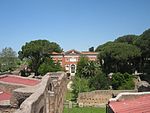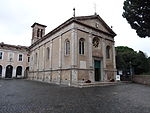Piazzale delle Corporazioni

The Forum of Corporations, or the Piazzale delle Corporazioni, was the principal center of commerce and trade for the Roman Empire mainly during the Age of Augustus. Located in the major port city of Ostia, this open-air market was essential for Rome as a place of varying and exotic goods from foreign lands. Merchants gathered here to sell anything from grain and shipping services to elephants and giraffes. Rebuilt in the 2nd century AD, the Forum of Corporations was also representative of the many diverse cultures that made up the Roman Empire. Oil importers, grain importers, rope-makers, and ship builders from corporations spanning across the empire came here to benefit from Ostia’s positioning at the mouth of the Tiber River, which easily facilitated the importation and transportation of goods into the empire.
Excerpt from the Wikipedia article Piazzale delle Corporazioni (License: CC BY-SA 3.0, Authors, Images).Piazzale delle Corporazioni
Via della Fontana, Rome Ostia Antica
Geographical coordinates (GPS) Address Nearby Places Show on map
Geographical coordinates (GPS)
| Latitude | Longitude |
|---|---|
| N 41.756388888889 ° | E 12.291111111111 ° |
Address
Piazzale delle Corporazioni
Via della Fontana
00119 Rome, Ostia Antica
Lazio, Italy
Open on Google Maps










